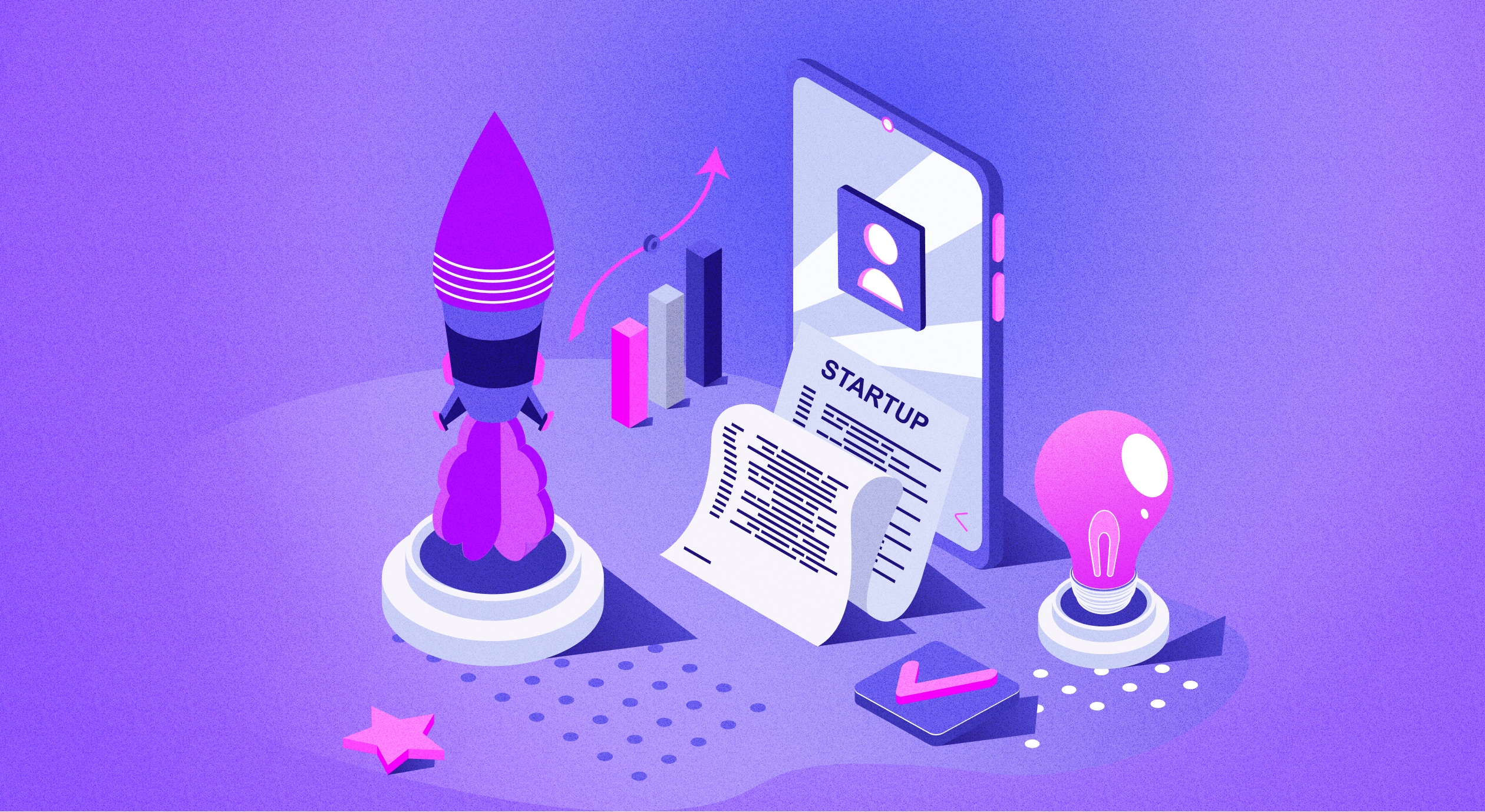
Trends-insights
15 min read
September 5, 2024

Updated: December 22, 2023
32 min read

Imagine this: people are roughly spending 7 hours on their phones every day in 2023, downloading 255 billion apps, making phones contribute to over 56% of total internet traffic.
While these statistics are surprising for a number of reasons, I want to highlight why they’re important for digital leaders, especially mobile app developers! Long gone are the days when websites ruled the digital world and were considered the best way to boost your business.
Today, 86% of the global population has access to a smartphone, making it the best way to reach a larger target audience. If that’s what you’re aiming to do, it’s time to build an app development team to bring your app idea to life.
But like any other aspect of life, mobile apps require a ton of thoughtful processes behind them. You’ll have to construct an app development team, hire resources like project managers to oversee the whole app development process, and so much more.
And I get it, you have many, many questions!
From mobile app development team structure to how much you can expect to spend on successful app development, we’ll cover everything in this blog. Let’s start with the people you’ll need on your dedicated team.
Bringing your app idea to life is the combined effort of many people on your team. While you can have different-sized teams for various projects, it’s recommended to ideally have 6–8 members on your app development team.
Each member is responsible for different aspects of the whole app development process, ensuring there is no burnout and that everyone plays to their own strengths!
Here are the 8 most important professionals your development process will need:
The Product Owner plays a pivotal strategic role, serving as the linchpin between business goals and the development process.
Firstly, the Product Owner serves as the voice of the customer. They gather and prioritize user requirements, ensuring that the app’s features and functionalities meet user needs. Their role involves creating and maintaining a product backlog—a prioritized list of features and tasks for the development team to work on.
The Product Owner is responsible for setting clear project goals and objectives. They define the product roadmap and determine what features should be developed in each release. Their decisions are driven by market research, user feedback, and a deep understanding of the competitive landscape.
Budget management is also within the Product Owner’s purview. They work closely with stakeholders to allocate resources effectively, ensuring that the development team can deliver features within budgetary constraints.
The Project Manager (PM) in a mobile app development team is the central figure responsible for orchestrating the workflow and ensuring that projects progress smoothly while staying within budgetary constraints. Their role is multifaceted and critical to the project’s success.
Firstly, Project Managers are instrumental in project planning. They work closely with stakeholders to define project objectives, scope, and requirements. They create comprehensive project plans, break down tasks, set milestones, and allocate resources. This planning phase is vital for establishing a clear roadmap for the team.
Resource management is another key responsibility. PMs allocate team members to tasks, making sure that the right skills are applied to specific project components. They monitor resource utilization to ensure efficiency while preventing over-allocation or burnout.
Budget oversight is a critical aspect of their role. PMs track project expenses, ensuring that costs align with the budget. They identify and manage financial risks, making adjustments as needed to keep the project financially viable.
PMs are timekeepers, responsible for managing project timelines. They monitor progress, identify bottlenecks, and make necessary adjustments to keep the project on schedule. Their ability to anticipate and mitigate potential delays is crucial.
Effective communication is at the heart of the PM’s role. They facilitate transparent and consistent communication among team members and stakeholders, providing regular updates on project status and addressing any concerns promptly.
The role of a Business Analyst (BA) is pivotal in the process of identifying and translating business needs into technical requirements within a project or organization. To a mobile app development team, they bring lots of value and contribution and are closely working with Product Managers and Project Managers.
BAs engage with Product Owners, Product Managers, and end-users, to gather and analyze objectives. This is often done in the form of interviews and surveys. They identify, document, prioritize, and validate business needs, ensuring that the resulting app not only meets these needs but also aligns with the organization’s strategic objectives.
Not only are they involved in testing and quality assurance procedures but are also responsible for facilitating collaboration, maintaining a strong user-centric perspective, and advocating with their domain expertise to achieve goals set by the Product Manager.
Their ability to communicate effectively, analyze requirements, and bridge the gap between business and technology is integral to the success of app development!
UI/UX Designers are integral members of a mobile app development team and have many responsibilities to bear within the team. First and foremost, UI UX Designers place the user at the forefront of their design process.
They delve deep into understanding user behavior, preferences, and pain points through extensive research and user personas. This user-centric approach forms the foundation of their work.
Designers create wireframes to outline the app’s layout and functionality and interactive prototypes that allow for testing and validation. They organize content and features in a logical and user-friendly manner, ensuring that users can navigate the app effortlessly.
In terms of aesthetics, UI UX Designers are responsible for the app’s visual and interactive design. They select color palettes, typography, animations, buttons, menus, icons, and imagery that not only align with the app’s brand identity but also create a functional and visually appealing interface.
Throughout the design process, UI UX Designers conduct usability testing to gather feedback from potential users. They work closely with developers, product managers, and other team members to ensure that design concepts can be effectively implemented and that the final product aligns with the overall project goals.
In a rapidly evolving technological landscape, UI/UX Designers also stay abreast of design trends and emerging technologies to keep app interfaces fresh and in line with user expectations.
Many successful apps are available on both iOS and Android devices, which helps them reach a larger audience easily. If that’s your plan, you’ll need to hire an iOS developer and an Android developer! These developers possess deep knowledge of their respective ecosystems, including programming languages, design principles, and platform-specific features.
This expertise enables them to optimize the app’s performance, ensuring it runs smoothly on iOS and Android devices. They also consider nuances such as screen sizes, device fragmentation, hardware capabilities, and platform-specific behaviors, leading to a more responsive and efficient user experience.
Both iOS and Android have strict policies for app submission and approval. Hence, iOS developers also ensure that the app complies with Apple’s App Store Review Guidelines, while Android developers must meet Google Play’s requirements.
To put it simply, backend developers are the backbone and architects behind the scenes, responsible for creating a robust, secure, and scalable infrastructure that powers mobile applications. These individuals are masters of numerous programming languages, making them an obligatory aspect of any mobile app development team.
Their primary responsibility is to create the infrastructure, databases, and server components that enable the app to function effectively.
Backend developers design and implement the database architecture, ensuring efficient data storage and retrieval. They establish secure data communication protocols to protect sensitive information, such as user data and authentication details.
Backend developers are also responsible for implementing the app’s business logic. This involves writing the code that processes user requests, handles server-side operations, and communicates with external services or APIs.
They ensure that the app functions smoothly by optimizing performance and minimizing response times. From creating APIs to connect front-end designs with the back-end infrastructure to enabling features like real-time updates and user authentication, backend developers are critical to integration!
Plus, they focus on scalability and reliability. Backend developers design the architecture to handle increased traffic and load as the app grows. They implement redundancy and failover mechanisms to ensure the app remains available even during server failures or high traffic spikes.
Quality Assurance (QA) Engineers play a crucial role in a mobile app development team by ensuring the final product is free from bugs and adheres to rigorous quality standards. Their primary responsibility is to meticulously test the app to identify and report any defects or issues.
QA Engineers are involved in the entire development lifecycle. They start by reviewing design and functional specifications to gain a comprehensive understanding of the app’s requirements. This early involvement allows them to create comprehensive test plans and strategies tailored to the app’s specific features and functionalities.
During development, QA Engineers conduct various types of testing, including functional, usability, performance, and security testing. They rigorously validate that the app works as intended, is user-friendly, responds quickly, and is secure against potential threats.
Collaboration is key as QA Engineers work closely with developers, designers, and other team members. They provide valuable feedback on identified issues, fostering a culture of continuous improvement and driving bug fixes and enhancements.
Sales and marketing specialists are the driving force behind promoting the app, attracting users, and ultimately contributing to its commercial success. In today’s competitive app marketplaces like Google Play and Apple App Store, your app might not get any downloads without an effective marketing specialist ensuring the app’s commercial success!
Sales and marketing specialists are responsible for crafting a compelling market strategy that targets your intended audience. To reach this audience, market specialists create a buzz and interest around the app using marketing tactics including:

One of the most common misconceptions people have is that the structure of a mobile app and software development team is the same. But they’re actually 2 different things!
I’ve gathered a quick but comprehensive table that explains the main differences between these team structures:
| Aspect | Mobile App Development Team | Traditional Software Development Team |
|---|---|---|
| Team Size | Smaller, focused team | Larger and more diverse team |
| Specialization | Platform-specific (iOS/Android) | Cross-platform (desktop, web, mobile) |
| Roles | Mobile Developers, UI/UX Designers, QA Engineers, Product Owner | Backend Developers, Frontend Developers, Database Administrators, System Architects, Business Analysts, etc. |
| User-Centric Focus | High emphasis on UI/UX design | Balanced emphasis on functionality and UI/UX design |
| Update Frequency | Frequent updates and iterations | Longer release cycles |
| Complexity of Development | Tends to be lower complexity due to mobile platform constraints | Can vary widely depending on the software application and its functionalities |
Like any part of life, it’s confusing to know where to begin when it comes to finding your ideal app development team! But the good news is that there are various places to look into and assemble your in-house team.
Here, I’ve gathered the 5 main ways to find yourself your mobile application development experts:
Picture this: a team you create exclusively for your project with people who have the exact skill sets you need and are unwaveringly motivated to achieve your goals.
That’s a dedicated team for a mobile app development team structure!
This team develops an in-depth understanding of project nuances, facilitating tailored solutions. Dedicated teams offer control and easily adapt to changing project dynamics and priorities. But finding a dedicated team takes time and effort on your part, so make sure you have a clear vision of what you’re looking for.
| Pros | Cons |
|---|---|
| Fully committed to your project | Lack of specialized skills or expertise |
| Deeply understands your business goals | Higher capital cost |
| Easier and direct communication | Challenging to scale the team up or down |
| Stronger collaborative skills | Requires extensive recruitment efforts |
| Greater control over team priorities and tasks |
In simple words, outsourcing means hiring a third-party company to create your app for you. In this process, you can provide all your input at the beginning of the project, so the company can analyze the project scope and price.
This way, you have little to no involvement in the creative processes. However, third-party app development companies often come with a team of experts and a vast portfolio of successful projects that you can check out before hiring them.
So, you can hire a company that suits your business goals and has a confident range of similar projects in their portfolio.
| Pros | Cons |
|---|---|
| Cost Efficiency and potential cost savings | May feature communication challenges |
| Access to specialized skills and experience | Lack of proper quality control and assurance |
| Flexibility to scale resources based on project needs | Sharing sensitive information leads to security and privacy concerns |
| Faster Time-to-Market | Limited Control |
| Allows in-house resources to concentrate on core business activities | Overreliance on outsourcing partners may result in a lack of in-house expertise |
If outsourcing doesn’t look like your fit because it limits your involvement, outstaffing might be something to consider. In outstaffing, you contract a third-party service provider to hire and manage a team on your behalf. The third party service provider is responsible for:
On the other hand, you retain control over project management, strategic decisions about work processes, and the day-to-day activities of the hired employees.
| Pros | Cons |
| Faster project execution | Quality control challenges with remote teams |
| Access to a broader talent pool and specialized skills | Initial recruitment and selection may be time-consuming |
| Ideal for temporary or project-based work | Dependency on the outstaffing provider’s performance |
| Reduced overhead costs and cost efficiency | Concerns about confidentiality and data security |
In house developers are full-time employees of a company who are responsible for designing, developing, and maintaining mobile applications within the organization. If you are a seasoned app owner, you might already have an in house team.
Within this umbrella, you have:
What really makes in-house developers special is their understanding and alignment with company values, goals, and culture. This way, you can create a cohesive team that is motivated to work closely to achieve the same results!
In-house developers provide stability, long-term commitment, and a strong sense of ownership over projects, making them essential contributors to the success of a mobile app development team.
| Pros | Cons |
| Direct control over the development process | Higher labor costs as well as overhead costs |
| Easier communication and coordination through cross-functional teams | Time-consuming recruitment, onboarding, and training processes |
| Immediate problem-solving and troubleshooting | Potential for overworking, leading to burnout |
| Enhanced data security and confidentiality | Limited scalability for fluctuating workload |
| Potential for long-term career growth and stability | Inability to keep up with the latest industry trends compared to other hiring methods |
Freelancers are independent professionals who offer their expertise and services on a project-by-project basis, often remotely. Because of that, they’re flexible, cost-effective, and know what they’re doing better than in-house teams.
In 2023, over 50% of companies have hired freelancers, and freelancing is projected to become USA’s majority workforce by 2027. Freelancers are thriving in a competitive environment and tend to stay updated on industry best practices with a vast skill set that can boost your mobile app development!
Moreover, freelancers often offer fresh perspectives and novel ideas, contributing to innovation within the team.
| Pros | Cons |
| Improved flexibility and scalability based on project needs | Concerns about data security and confidentiality when sharing sensitive information |
| Lower hourly rates and costs | Cultural and communication differences may impact collaboration |
| Greater access to experienced and skilled | Complex tax and legal considerations |
| Quicker recruitment process and turnaround time | Less direct control over freelancers’ work schedules |
| Up-to-date with industry best practices |
2024 subscription benchmarks and insights
Get your free copy of our latest subscription report to stay ahead in 2024.
Now, it’s time to address the elephant in the room: Laiba, how do I know how big of a team I need for my app idea?!
Well, the size of your mobile application development team depends on various factors. There is no standard size or a fixed ballpark figure that can give you the answer with a quick Google search.
At least, not accurately!
Instead, I want to dive into the 3 main factors that affect the size of your app dev team. Here are those 3 factors:
Of course, there’s often a budget to stick to unless you’re a billionaire boss! Having a budget involves a trade-off between team size and project quality. This makes it easy for product owners to acknowledge the skill set and number of people they can hire.
As with any industry, hiring a world-class team with rich experiences and skill sets comes with a mighty hourly rate. On the other hand, modest budgets mean you’ll have to sacrifice quality and/or quantity, leaving a lasting impression on your final product. It also means less financial risk for startups!
But budgets impact more than just your resource allocation.
These are closely tied to your project scope and objectives set by the Product Owner. A larger scope that must be developed quickly will require an expansive budget. With a big budget, you can hire a larger team, which streamlines and speeds up the developmental process and timeline.
Project complexity, scope, and app features and functionality are critical factors that significantly influence the size of your app development team. These factors determine the workload, technical requirements, and expertise needed to successfully execute your app project.
Complex projects often demand a larger development team. You can analyze your project complexity from:
But for simpler apps, your ideal development team structure will require only a handful of people!
The specific features and functionalities required in your app are a primary driver of team size. Apps with complex features such as real-time chat, payment processing, or geolocation services may require dedicated developers or specialists.
Moreover, a feature-rich app demands thorough testing and quality assurance efforts, which can also impact your team size.
Lastly, the scope of your app project directly correlates with the size of the development team. A broader scope, including multiple platforms (e.g., iOS and Android), additional features, and extensive user interfaces, warrants a larger team to meet the increased workload.
Expanding the project scope without adjusting the team size can lead to delays and compromised quality. You also need to keep in mind that overloading a small team with a complex project beyond their skills can cause burnout!
Ask yourself this, “how many people will be realistically using my app?”
While this might come off as entirely random, it’s a proven factor that impacts how many people you’ll need to maintain, scale, and keep your app from having less than smooth sailings.
If your app is designed to handle significant growth, especially in terms of users or data volume, a larger development team may be necessary.
This team can work on building a scalable architecture, implementing load balancing, optimizing database performance, and creating efficient code to support the expected growth without compromising on app performance.
Beyond user base size, user engagement is essential. Apps with high user engagement, frequent interactions, and real-time features, such as social media or messaging apps, often require larger teams to maintain and enhance the user experience. A larger team can also address user feedback, troubleshoot issues, and release updates more effectively, ensuring user satisfaction and retention.
But I’ll let you in on a secret…
One thing combats the need for a larger team to handle a diverse user base: the quality of resources at your hand.
If you hire a team of industry experts, efficiency is boosted, and you won’t need to hire more talent to keep up with demands. If this sounds exaggerated, check out Whatsapp’s developer team. Despite handling over 5 billion messages every year from over 2.7 active users, WhatsApp has only 55 developers on its team!
Hurray, you have a mobile app development team together! Now, let’s talk about the actual process this dedicated team will undergo, with the project manager spearheading the managerial aspects.
In this section, I’ve broken down the app development process into 5 stages. But before we move on to those, I want to mention that your actual process can look different depending on various factors.
From the way your project manager and product manager streamline processes to hiring a mobile app development company with their own protocols, your app development stages are just as unique as your mobile app idea!
That said, here are the 5 main app development stages:
In the initial stage of mobile app development, project strategy is the foundation upon which your app’s success is built. Effective project strategy sets the direction for the entire development process.
This phase involves defining your goals, project scope, and high-level planning. You’ll establish what you want to achieve with your app in terms of app features and functionalities, as well as identify your target audience.
One of the most important aspects of your project strategy is creating a roadmap for the project. In your project roadmap, the product manager or project manager will often create well-defined timelines, milestones, and resource allocation.
This is the time to align your app concept with your business objectives and outline the key features and functionalities it will offer.
Before diving into development, idea validation is a critical step. This phase involves assessing the viability of your app concept in the real-world market.
This phase goes beyond mere ideas and dives deep into market research. From surveys and interviews to prototype testing and focus group analysis, market research can be one of the most cathartic parts of the app development process.
But it’s always a good idea to hire a marketing specialist who can conduct thorough market research to:
Idea validation helps ensure that your app addresses a genuine problem or need, increasing its chances of success in the competitive app marketplace.
If you don’t have the financial resources to hire a marketing specialist to be part of your in-house team or your remote app development team, you can perhaps look into a freelancer who can do this for you at a much cheaper and quicker rate!
The UI UX strategy phase is dedicated to crafting a seamless and engaging user experience. User personas are created to understand the characteristics, preferences, and pain points of the target audience.
This stage involves meticulous planning of the app’s information architecture, ensuring logical organization and navigation. Wireframing and prototyping are key activities that translate design concepts into tangible visuals and interactive prototypes, allowing for user testing and feedback.
But what part of your mobile app development team structure is applied in this section? It’s the UI UX designers, of course!
By prioritizing user-centric design and usability, the UI UX designer sets the stage for an app that not only looks appealing but also provides an intuitive and satisfying user journey.
In the design and development phase, the project moves from planning to execution. Front-end developers are tasked with building the user interface (UI) and implementing user interactions, translating design concepts into tangible visual elements. The designs from the UI UX designers are taken by your in-house developers and turned into interactive app features.
Meanwhile, backend developers work on the server-side logic, databases, and APIs that power the app’s functionality. Integration of third-party services, if required, and the implementation of robust security measures are integral to this phase.
Thanks to backend developers and other app development programmers, this stage transforms the conceptual ideas and designs into functional code, effectively bringing your app vision to life!
The testing and improving phase represents the meticulous process of ensuring that the app meets quality and performance standards. This phase is instrumental in delivering a polished and high-quality app ready for a successful launch.
Quality Assurance (QA) testing encompasses a range of evaluations, including functional, usability, performance, and security testing. Here, the QA engineers are responsible for testing the mobile apps to the extreme limits. Bugs and issues are identified, documented, and prioritized for resolution by the QA engineer.
After gathering thorough usability testing and real-world usage, user feedback is systematically integrated into the app’s ongoing refinements. Load testing assesses the app’s stability under varying conditions, and compatibility testing ensures a seamless user experience across diverse devices and platforms.
According to Clutch, the average app development project falls typically in the range of $5,000 to $10,000. But they also noted that this was just the discovery phase of development and is not representative of the total cost.
In a general sense, you can estimate the cost of your mobile app development project by multiplying the number of developer hours required by the hourly rate charged by your developers. Let’s talk about this in terms of man-hours.
If your project requires 200 hours from your developer who charges $30 per hour, the cost of your development is $6,000. But this doesn’t include the cost of hiring project managers, marketing specialists, or QA engineers.
On the other hand, GoodFirms provides a more comprehensive breakdown. They categorize app development costs based on complexity, with a basic app ranging from $40,000 to $60,000, a medium complexity app between $61,000 to $69,000, and a feature-rich app falling in the range of $70,000 to $100,000.
It’s easier said than done to estimate the total cost of your app development team because it relies on many factors such as:
Here we are at the end of this blog post and hopefully more knowledgeable about how you can build a development team for your mobile app startup!
In the realm of mobile app startups, where competition is fierce, and user expectations are high, assembling the right team is a strategic move. It ensures that the app not only meets but exceeds user expectations, enhancing its chances of success in the market.
As to who you’ll need on your team, where to find them, and how much they’ll cost you, we’ve covered all those nuances today. The only thing left to do now is get your app idea rolling out with the perfect team by your side.
Recommended posts

Trends-insights
15 min read
September 5, 2024

Product-releases
October 11, 2022